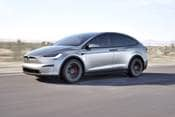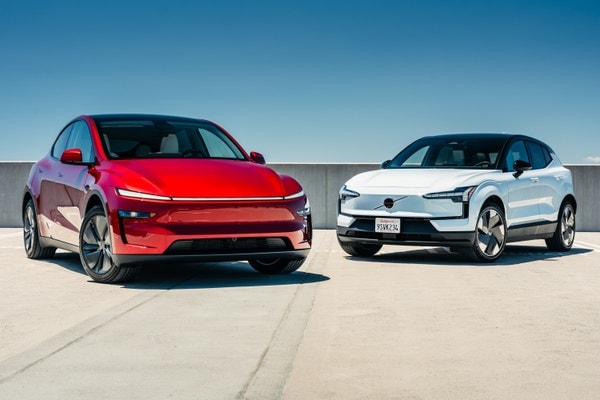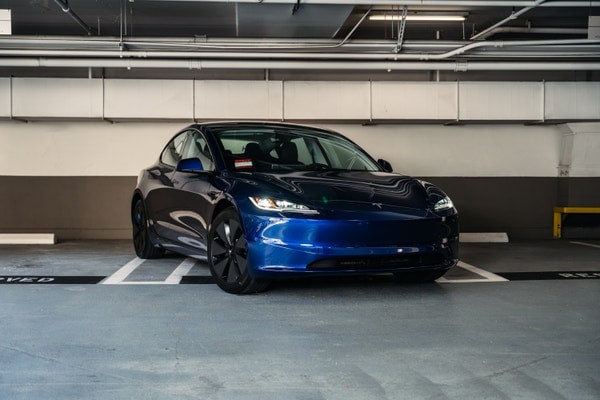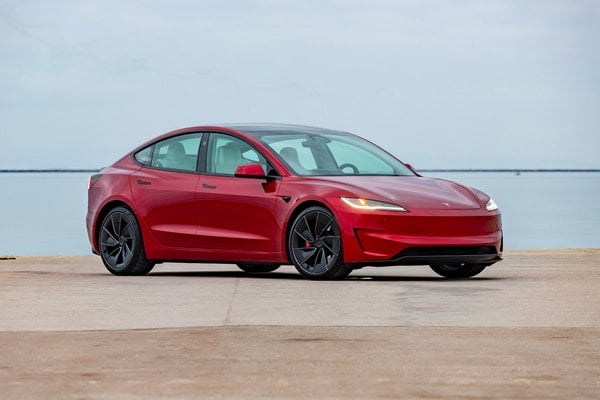2024 Tesla Model X
Price Range: $79,990 - $94,990
Helpful shopping links
2024 Tesla Model X video
Rivian R1S vs. Tesla Model X Plaid | Three Row EV SUV Comparison Test | Which Luxury EV SUV Is Best?
NOTE: This video is about the 2022 Tesla Model X, but since the 2024 Tesla Model X is part of the same generation, our earlier analysis still applies.
The Rivian R1S and Tesla Model X Plaid each take a very different approach to the large luxury three-row EV SUV segment — a segment in which they're essentially the only two major players. Tesla's got years of experience under its belt at this point — though it's definitely still a startup — while Rivian is the newcomer looking to fight. Both SUVs are mega-powerful and lay… down performance figures that seem to defy the laws of physics, and both boast impressive electric rangers. So, which one comes out on top? Join Edmunds' Ryan ZumMallen in the video above to find out!
PRICE CHECKER™
Check a dealer's price
Bring back a dealer's quote, and we'll tell you if it's a good price!
Check your price quote
Price:
$ -
Graph shown is a sample only
FAQ
Is the Tesla Model X a good car?
The Edmunds experts tested the 2024 Model X both on the road and at the track, giving it a 8.1 out of 10. Edmunds’ consumer reviews show that the 2024 Model X gets an average rating of 3 stars out of 5 (based on 36 reviews) What about cargo capacity? When you're thinking about carrying stuff in your new car, keep in mind that carrying capacity for the Model X ranges from 21.5 to 43.6 cubic feet of trunk space. And then there's safety and reliability. Edmunds has all the latest NHTSA and IIHS crash-test scores, plus industry-leading expert and consumer reviews to help you understand what it's like to own and maintain a Tesla Model X. Learn more
What's new in the 2024 Tesla Model X?
According to Edmunds’ car experts, here’s what’s new for the 2024 Tesla Model X:
- New deep Ultra Red paint option
- Lighter and more transparent glass roof
- Plaid trim gets upgraded brake pads
- Part of the first Model X generation that debuted for 2016
Is the Tesla Model X reliable?
To determine whether the Tesla Model X is reliable, read Edmunds' authentic consumer reviews, which come from real owners and reveal what it's like to live with the Model X. Look for specific complaints that keep popping up in the reviews, and be sure to compare the Model X's 3-star average consumer rating to that of competing vehicles. Learn more
Is the 2024 Tesla Model X a good car?
There's a lot to consider if you're wondering whether the 2024 Tesla Model X is a good car. Edmunds' expert testing team reviewed the 2024 Model X and gave it a 8.1 out of 10. Our consumer reviews show that the 2024 Model X gets an average rating of 3 stars out of 5 (based on 36 reviews). Safety scores, fuel economy, cargo capacity and feature availability should all be factors in determining whether the 2024 Model X is a good car for you. Learn more
How much should I pay for a 2024 Tesla Model X?
The least-expensive 2024 Tesla Model X is the 2024 Tesla Model X 4dr SUV AWD (electric DD). Including destination charge, it arrives with a Manufacturer's Suggested Retail Price (MSRP) of about $79,990.
Other versions include:
- 4dr SUV AWD (electric DD) which starts at $79,990
- Plaid 4dr SUV AWD (electric DD) which starts at $94,990
What are the different models of Tesla Model X?
If you're interested in the Tesla Model X, the next question is, which Model X model is right for you? Model X variants include 4dr SUV AWD (electric DD), and Plaid 4dr SUV AWD (electric DD). For a full list of Model X models, check out Edmunds’ Features & Specs page. Learn more












